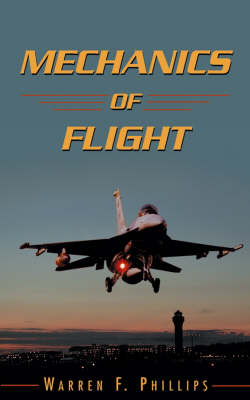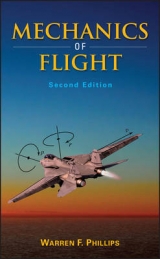
Mechanics of Flight
John Wiley & Sons Inc (Verlag)
978-0-471-33458-3 (ISBN)
- Titel erscheint in neuer Auflage
- Artikel merken
"Mechanics of Flight" is a unique combination of theory and applications organized in a logical presentation. It affords readers' extensive coverage of individual topics within flight mechanics, including overviews of aerodynamics and propulsion. It also offers a full range of modern and classical techniques for applying fundamental principles to the solution of engineering problems in fight mechanics. "Mechanics of Flight" explores the basic principles of flight mechanics with the help of many worked examples, starting with simple problems involving steady-level flight and building to more complex ones, such as the analysis of turning flight and spins. Special coverage found here - and not in most books on the subject - includes a detailed presentation of the quaternion formulation for six-degree-of-freedom flight simulation, including treatment of efficient numerical integration methods.
WARREN F. PHILLIPS is Professor of Mechanical and Aerospace Engineering at Utah State University and has more than thirty years of experience teaching engineering analysis and design. He is the author of more than fifty scientific journal publications, including thirteen Journal of Aircraft publications on aerodynamics and flight mechanics during the last four years.
Preface.Acknowledgments.1. Overview of Aerodynamics.1.1. Introduction and Notation.1.2. Fluid Statics and the Atmosphere.1.3. The Boundary Layer Concept.1.4. Inviscid Aerodynamics.1.5. Review of Elementary Potential Flows.1.6. Incompressible Flow over Airfoils.1.7. Trailing-Edge Flaps and Section Flap Effectiveness.1.8. Incompressible Flow over Finite Wings.1.9. Flow over Multiple Lifting Surfaces.1.10. Inviscid Compressible Aerodynamics.1.11. Compressible Subsonic Flow.1.12. Supersonic Flow.1.13. Problems.2. Overview of Propulsion.2.1. Introduction.2.2. The Propeller.2.3. Propeller Blade Theory.2.4. Propeller Momentum Theory.2.5. Off-Axis Forces and Moments Developed by a Propeller.2.6. Turbojet Engines: The Thrust Equation.2.7. Turbojet Engines: Cycle Analysis.2.8. The Turbojet Engine with Afterburner.2.9. Turbofan Engines.2.11. Problems.3. Aircraft Performance.3.1. Introduction.3.2. Thrust Required.3.3. Power Required.3.4. Rate of Climb and Power Available.3.5. Fuel Consumption and Endurance.3.6. Fuel Consumption and Range.3.7. Power Failure and Gliding Flight.3.8. Airspeed, Wing Loading, and Stall.3.9. The Steady Coordinated Turn.3.10. Takeoff and Landing Performance.3.11. Accelerating Climb and Balanced Field Length.3.12. Problems.4. Longitudinal Static Stability and Trim.4.1. Fundamentals of Static Equilibrium and Stability.4.2. Pitch Stability of a Cambered Wing.4.3. Simplified Pitch Stability Analysis for a Wing-Tail Combination.4.4. Stick-Fixed Neutral Point and Static Margin.4.5. Estimating the Downwash Angle on an Aft Tail.4.6. Simplified Pitch Stability Analysis for a Wing-Canard Combination.4.7. Effects of Drag and Vertical Offset.4.8. Contribution of the Fuselage and Nacelles.4.9. Contribution of Running Propellers.4.10. Contribution of Jet Engines.4.11. Problems.5. Lateral Static Stability and Trim.5.1. Introduction.5.2. Yaw Stability and Trim.5.3. Estimating the Sidewash Gradient on a Vertical Tail.5.4. Estimating the Lift Slope for a Vertical Tail.5.5. Roll Stability and Dihedral Effect.5.6. Roll Control and Trim Requirements.5.7. Longitudinal-Lateral Coupling.5.8. Control Surface Sign Conventions.5.9. Problems.6. Aircraft Controls and Maneuverability.6.1. Longitudinal Control and Maneuverability.6.2. Effects of Structural Flexibility.6.3. Control Force and Trim Tabs.6.4. Stick-Free Neutral and Maneuver Points.6.5. Ground Effect, Elevator Sizing, and CG Limits.6.6. Stall Recovery.6.7. Lateral Control and Maneuverability.6.8. Aileron Reversal.6.9. Other Control Surface Configurations.6.10. Airplane Spin.6.11. Problems.7. Aircraft Equations of Motion.7.1. Introduction.7.2. Newton's Second Law for Rigid-Body Dynamics.7.3. Position and Orientation: The Euler Angle Formulation.7.4. Rigid-Body 6-DOF Equations of Motion.7.5. Linearized Equations of Motion.7.6. Force and Moment Derivatives.7.7. Nondimensional Linearized Equations of Motion.7.8. Transformation of Stability Axes.7.9. Inertial and Gyroscopic Coupling.7.10. Problems.8. Linearized Longitudinal Dynamics.8.1. Fundamentals of Dynamics: Eigenproblems.8.2. Longitudinal Motion: The Linearized Coupled Equations.8.3. Short-Period Approximation.8.4. Long-Period Approximation.8.5. Pure Pitching Motion.8.6. Summary.8.7. Problems.9. Linearized Lateral Dynamics.9.1. Introduction.9.2. Lateral Motion: The Linearized Coupled Equations.9.3. Roll Approximation.9.4. Spiral Approximation.9.5. Dutch Roll Approximation.9.6. Pure Rolling Motion.9.7. Pure Yawing Motion.9.8. Longitudinal-Lateral Coupling.9.9. Nonlinear Effects.9.10. Summary.9.11. Problems.10. Aircraft Handling Qualities and Control Response.10.1. Introduction.10.2. Pilot Opinion.10.3. Dynamic Handling Quality Prediction.10.4. Response to Control Inputs.10.5. Nonlinear Effects and Longitudinal-Lateral Coupling.10.6. Problems.11. Aircraft Flight Simulation.11.1. Introduction.11.2. Euler Angle Formulations.11.3. Direction-Cosine Formulation.11.4. Euler Axis Formulation.11.5. The Euler-Rodrigues Quaternion Formulation.11.6. Quaternion Algebra.11.7. Relations between the Quaternion and Other Attitude Descriptors.11.8. Applying Rotational Constraints to the Quaternion Formulation.11.9. Closed-Form Quaternion Solution for Constant Rotation.11.10. Numerical Integration of the Quaternion Formulation.11.11. Summary of the Flat-Earth Quaternion Formulation.11.12. Aircraft Position in Geographic Coordinates.11.13. Problems.Bibliography.Appendixes.A: Standard Atmosphere, SI Units.B: Standard Atmosphere, English Units.Index.
| Erscheint lt. Verlag | 25.2.2004 |
|---|---|
| Zusatzinfo | illustrations |
| Verlagsort | New York |
| Sprache | englisch |
| Maße | 161 x 244 mm |
| Gewicht | 1446 g |
| Themenwelt | Technik ► Maschinenbau |
| ISBN-10 | 0-471-33458-8 / 0471334588 |
| ISBN-13 | 978-0-471-33458-3 / 9780471334583 |
| Zustand | Neuware |
| Haben Sie eine Frage zum Produkt? |
aus dem Bereich



